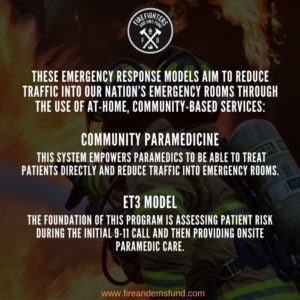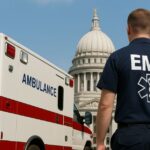One of the big lessons of the Covid-19 pandemic is that our medical system is not immune to vulnerability. Three of the perennial problems in emergency services have been funding, proper staffing, and access to adequate resources to serve the community. A once in a century pandemic like Covid-19 led to decreased tax revenues, overworked, and exposed personnel, and a drain on material resources, which painfully brought these longstanding issues to the forefront of public life.
Creative solutions can help ease the pressure put on the traditional medical system. Below are two examples of recent models which aim to reduce traffic into our nation’s emergency rooms through the use of at-home, community-based services.
Community Paramedicine
As EMS1 notes, this form of medical care is common in rural communities and places where there are limited resources for medical care. This system relies on paramedics, with additional training, playing more than one role in the caregiving process. “In some cases, paramedics with additional training act as the patient’s primary care provider, checking up on them and managing their medical conditions…They commonly provide fluids, oxygen, albuterol and furosemide.” This model can be particularly beneficial to the elderly.
The primary benefit of this model of care is helping reduce pressure on emergency units:

“A BMJ study found that community paramedics can adequately manage and treat various medical conditions that would normally result in the patient being transported to the ED…“
“They are supported by nurses and physicians who triage patients and are given the freedom to decide how to treat and whether their patient needs higher care. Ultimately, this leads to fewer ED visits.“
This system empowers paramedics to be able to treat patients directly and reduce traffic into emergency rooms, but likewise, offers a dynamic solution in which paramedics can still determine that a patient needs more extensive treatment at the hospital once the situation is assessed on-scene.
ET3 Model
EMS1 describes the ET3 model as the following:
“Emergency Triage, Treat and Transport Model, or ET3 – will make it possible for participating EMS agencies to partner with qualified healthcare providers to deliver treatment in place (on-scene or via telehealth) and with alternative destination sites (such as primary care doctors’ offices or urgent-care clinics).“
This program was developed by the Center for Medicare and Medicaid Services with the aim of reducing the need for transporting patients to the hospital. This program was initially set for a 5-year pilot, beginning on May 1, 2020, but the Covid-19 pandemic pushed the launch to January 1, 2021. Projections estimated that the program could save the healthcare system up to $560 million per year.The foundation of this program is assessing patient risk during the initial 9-11 call and then providing onsite paramedic care. “Once the ambulance arrives, EMS treats in place (e.g., giving dextrose to a hypoglycemic patient) and are supported by a “qualified healthcare practitioner,” either in person or via telehealth.” A physician, physician’s assistant, or nurse practitioner would then assume care for the patient at the appropriate threshold once the initial emergency subsides without hospital transport.
Image Credit: Photo by Benjamin Voros on Unsplash









